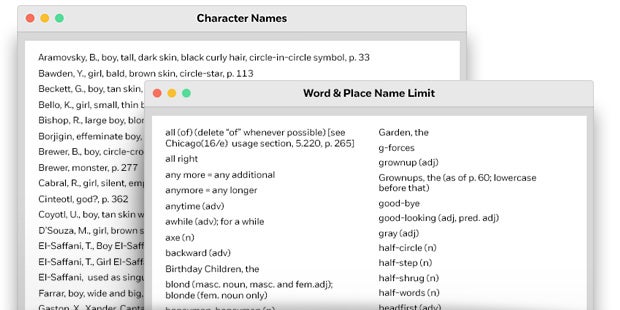We recently learned about the challenges authors face in maintaining continuity while writing. Fortunately, a key stage in the editorial process helps ensure that a book is, ultimately, the best version of itself it can be. Some authors have been known to praise copy editors as publishing’s unsung heroes. We checked in with a Random House copy editor to learn about what she looks for in a manuscript and how she gets the job done.
Q: What does a copy editor look for when reviewing a manuscript?
A: When I’m copyediting, I keep an open Word document into which I jot notes about anything I think may be of interest as I keep track of chronology, logistics, plot, and personal details. I’ll make notes about dates, characters’ ages and physical appearances, characters’ past experiences, layouts of houses or towns—anything that might be mentioned repeatedly over the course of a manuscript.

Q: What are common continuity issues that copy editors encounter?
A: Probably the most common issues are lapses in chronology—from day-to-day passage of time to a storyline’s trajectory over years—and in character continuity, including physical characteristics and personal histories. This is especially true when working on historical novels, where real-life events and characters overlap with fictional ones. Keeping a detailed timeline and character notes is essential, particularly when I find myself working on multiple titles in an ongoing series. That said, chronological issues occur in stories with simple timelines almost as often as they do in stories with complex ones.
Q: What are some examples of timeline glitches?
A: Something like characters having breakfast then driving from Philadelphia to Boston before lunchtime. Or it’s a Sunday in the book’s internal logic, but the main scene in the chapter takes place at a government office. The extent to which this sort of fact-checking is critical to copyediting fiction often surprises people outside of publishing, but it’s essential. Because even if a single date is never specified, characters can’t (although it’s come up) be wearing overcoats for eleven months of the year in New York City. And you pretty much never get two full moons a week apart. And when two blue-eyed parents have a brown-eyed baby, you have to wonder whether the author is hinting at an affair, rather than just not being well versed in genetics.
Q: How do you keep track of everything that happens in a story?
A: Calendars can be very useful for working out what’s happened when; maps and atlases are essential for making sense of place. Going against the tide of an author’s free-flowing creativity, I create a detailed timeline to ensure continuity among the events of a story and the integrity of each scene. Timeline issues are much harder to tease out with search-and-replace tools than things like how a character’s name is spelled (which, needless to say, is rather important) or whether the word “Internet” is capitalized, so they require the copy editor’s sustained attention.
Q: What can an author expect to receive from a copy editor?
A: Authors receive a formal style sheet that is meant to explain, as they’re reviewing the copyedited manuscript, what went on in the copyediting. They can expect to see notes about overall style choices, such as “series comma is used” or “cap first word of full sentence following a colon.” Style sheets also include lists of odd or interesting words, particularly if a non-dictionary spelling is being used, and should also contain just about every proper noun in the book (all of which the copy editor has looked up to confirm spelling and, as much as possible, accurate use).
An author may also receive a separate timeline. Timelining is a tedious process, and the multiple, often confusing cross-references and queries from an attentive copy editor may cause stress for an author during revision. But after all the fixes are in, the result is a seamless story in which readers can lose themselves, and persuasive characters whom readers can embrace.
Q: Do you have any advice for authors struggling to maintain continuity in their manuscripts?
A: Outline, outline, outline. Also: Outline.
Milena Schmidt is part of the Consumer Marketing Development and Operations Group.


